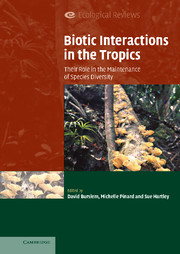Book contents
- Frontmatter
- Contents
- List of contributors
- Preface
- PART I Plant–plant interactions
- PART II Plant–microbe interactions
- 6 Dimensions of plant disease in tropical forests
- 7 Mycorrhizas and ecosystem processes in tropical rain forest: implications for diversity
- 8 An overview of arbuscular mycorrhizal fungal composition, distribution and host effects from a tropical moist forest
- 9 Tropical plants as chimera: some implications of foliar endophytic fungi for the study of host-plant defence, physiology and genetics
- PART III Plant–animal interactions
- PART IV Biotic interactions in human-dominated landscapes
- Index
- References
6 - Dimensions of plant disease in tropical forests
Published online by Cambridge University Press: 25 August 2009
- Frontmatter
- Contents
- List of contributors
- Preface
- PART I Plant–plant interactions
- PART II Plant–microbe interactions
- 6 Dimensions of plant disease in tropical forests
- 7 Mycorrhizas and ecosystem processes in tropical rain forest: implications for diversity
- 8 An overview of arbuscular mycorrhizal fungal composition, distribution and host effects from a tropical moist forest
- 9 Tropical plants as chimera: some implications of foliar endophytic fungi for the study of host-plant defence, physiology and genetics
- PART III Plant–animal interactions
- PART IV Biotic interactions in human-dominated landscapes
- Index
- References
Summary
Introduction
Pest pressure is the inevitable, ubiquitous factor in evolution which makes for an apparently pointless multiplicity of species in all areas in which it has time to operate.
(Gillett 1962)At a symposium 44 years ago, J. B. Gillett proposed the Theory of Pest Pressure, whereby plant pathogens and pests were responsible for the genesis and maintenance of high plant diversity in tropical forests and other high-diversity systems. In his conclusion to the paper produced from that talk he hoped that this ‘new theory may be useful in stimulating discussion and research’ on the roles of pests and pathogens as a force in plant diversity. Apparently his theory has been useful, as much has happened in the last four decades to explore and expand on his idea. My aim is to review key research on the effects of plant pathogens in tropical forests since Gillett's seminal paper with emphasis on the special case of his Theory of Pest Pressure known as the Janzen–Connell Hypothesis. I will also suggest critical areas that need to be explored as we continue to discuss and research the role of pathogens in the maintenance of species diversity in tropical forests.
‘Parcere subiectis et debellare superbos’
Gillett (1962) paraphrased Virgil's famous formula for the greatness of Rome, ‘Spare the lowly and conquer the haughty’ (AeneidVI: 853), when he first introduced the idea that if plant pests have a greater impact on more common species than on rare species, the rare species should then increase in relative frequency, providing a mechanism for the maintenance of diversity in species-rich communities.
- Type
- Chapter
- Information
- Biotic Interactions in the TropicsTheir Role in the Maintenance of Species Diversity, pp. 141 - 164Publisher: Cambridge University PressPrint publication year: 2005
References
- 45
- Cited by

